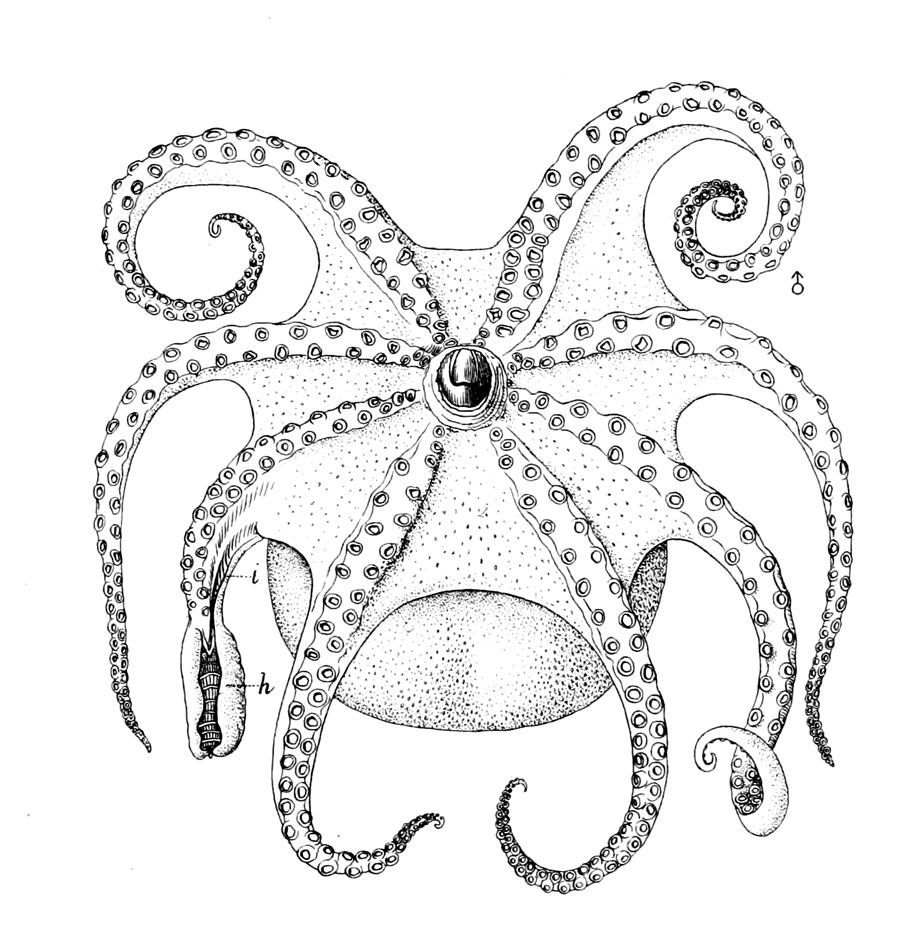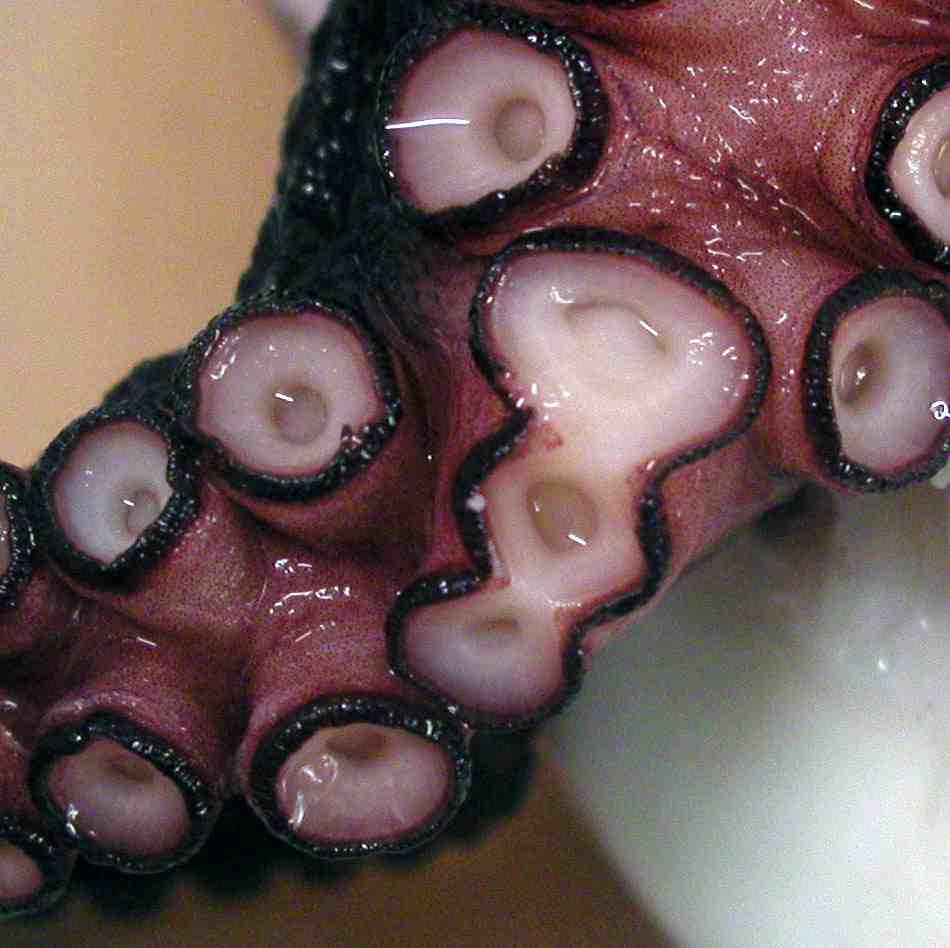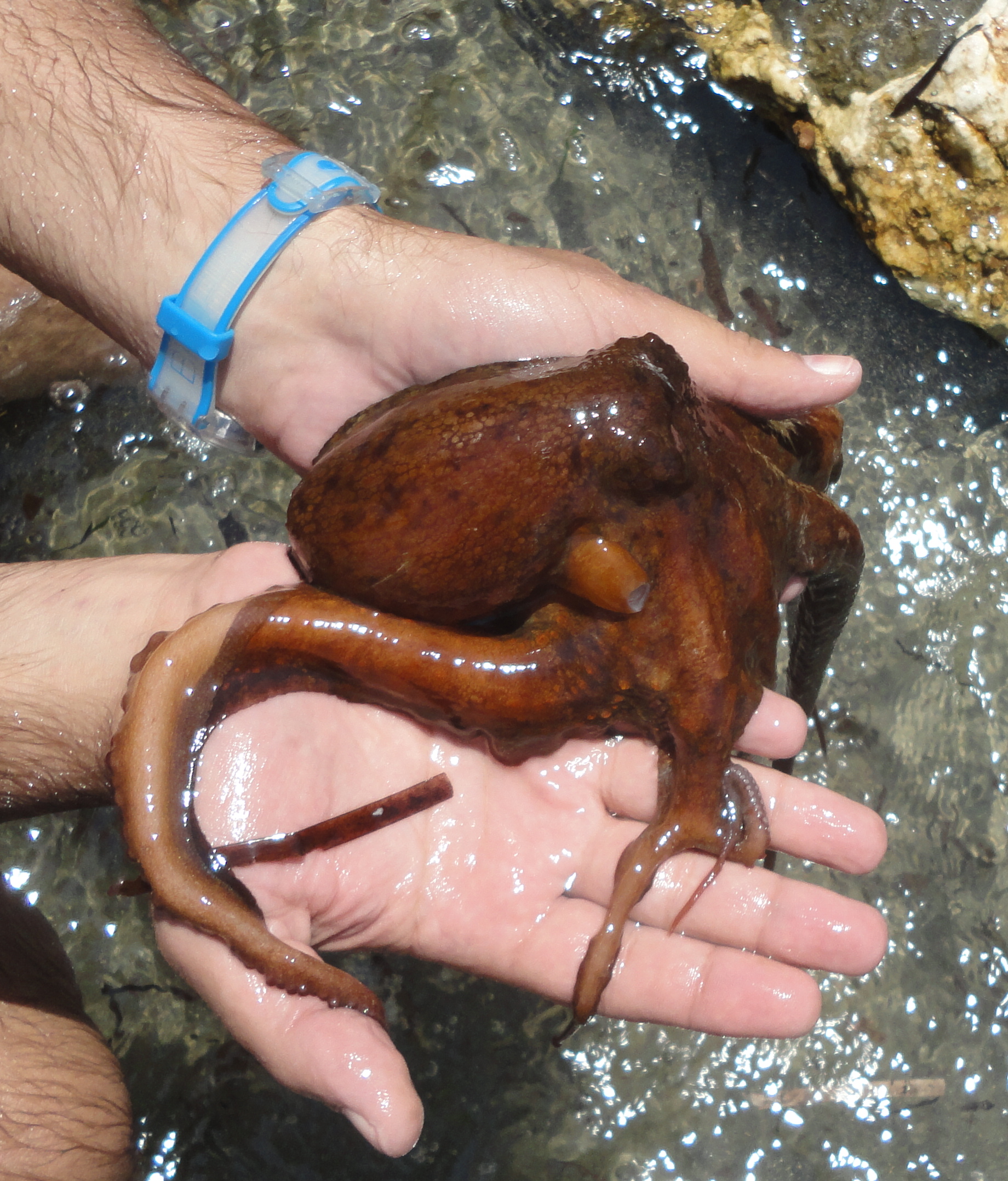Cephalopod Limb on:
[Wikipedia]
[Google]
[Amazon]









 All
All
Cephalopoda Glossary
Tree of Life web project. Barring a few exceptions,









 All
All cephalopod
A cephalopod is any member of the molluscan class Cephalopoda (Greek plural , ; "head-feet") such as a squid, octopus, cuttlefish, or nautilus. These exclusively marine animals are characterized by bilateral body symmetry, a prominent head ...
s possess flexible limbs extending from their heads and surrounding their beaks
The beak, bill, or rostrum is an external anatomical structure found mostly in birds, but also in turtles, non-avian dinosaurs and a few mammals. A beak is used for eating, preening, manipulating objects, killing prey, fighting, probing for food, ...
. These appendages, which function as muscular hydrostat
A muscular hydrostat is a biological structure found in animals. It is used to manipulate items (including food) or to move its host about and consists mainly of muscles with no skeletal support. It performs its hydraulic movement without fluid in ...
s, have been variously termed arms, legs or tentacles.
Description
In the scientific literature, a cephalopod ''arm'' is often treated as distinct from a ''tentacle
In zoology, a tentacle is a flexible, mobile, and elongated organ present in some species of animals, most of them invertebrates. In animal anatomy, tentacles usually occur in one or more pairs. Anatomically, the tentacles of animals work main ...
'', though the terms are sometimes used interchangeably, often with the latter acting as an umbrella term
In linguistics, semantics, general semantics, and ontologies, hyponymy () is a semantic relation between a hyponym denoting a subtype and a hypernym or hyperonym (sometimes called umbrella term or blanket term) denoting a supertype. In other wor ...
for cephalopod limbs. Generally, arms have suckers along most of their length, as opposed to tentacles, which have suckers only near their ends.Young, R.E., M. Vecchione & K.M. Mangold 1999Cephalopoda Glossary
Tree of Life web project. Barring a few exceptions,
octopus
An octopus ( : octopuses or octopodes, see below for variants) is a soft-bodied, eight- limbed mollusc of the order Octopoda (, ). The order consists of some 300 species and is grouped within the class Cephalopoda with squids, cuttle ...
es have eight arms and no tentacles, while squid
True squid are molluscs with an elongated soft body, large eyes, eight arms, and two tentacles in the superorder Decapodiformes, though many other molluscs within the broader Neocoleoidea are also called squid despite not strictly fitting t ...
and cuttlefish
Cuttlefish or cuttles are marine molluscs of the order Sepiida. They belong to the class Cephalopoda which also includes squid, octopuses, and nautiluses. Cuttlefish have a unique internal shell, the cuttlebone, which is used for control of ...
have eight arms (or two "legs" and six "arms") and two tentacles.Norman, M. 2000. ''Cephalopods: A World Guide''. ConchBooks, Hackenheim. p. 15. "There is some confusion around the terms ''arms'' versus ''tentacles''. The numerous limbs of nautilus
The nautilus (, ) is a pelagic marine mollusc of the cephalopod family Nautilidae. The nautilus is the sole extant family of the superfamily Nautilaceae and of its smaller but near equal suborder, Nautilina.
It comprises six living species in t ...
es are called tentacles. The ring of eight limbs around the mouth in cuttlefish, squids and octopuses are called ''arms''. Cuttlefish and squid also have a pair of specialised limbs attached between the bases of the third and fourth arm pairs .. These are known as ''feeding tentacles'' and are used to shoot out and grab prey." The limbs of nautilus
The nautilus (, ) is a pelagic marine mollusc of the cephalopod family Nautilidae. The nautilus is the sole extant family of the superfamily Nautilaceae and of its smaller but near equal suborder, Nautilina.
It comprises six living species in t ...
es, which number around 90 and lack suckers altogether, are called cirri.
The tentacles of Decapodiformes
Decapodiformes is a superorder of Cephalopoda comprising all cephalopod species with ten limbs, specifically eight short arms and two long tentacles. It is hypothesized that the ancestral coleoid had five identical pairs of limbs, and that one ...
are thought to be derived from the fourth arm pair of the ancestral coleoid
Subclass Coleoidea,
or Dibranchiata, is the grouping of cephalopods containing all the various taxa popularly thought of as "soft-bodied" or "shell-less" (i.e., octopuses, squid and cuttlefish). Unlike its extant sister group, Nautiloidea, whose ...
, but the term ''arms IV'' is used to refer to the subsequent, ventral arm pair in modern animals (which is evolutionarily the fifth arm pair).
The males of most cephalopods develop a specialised arm for sperm delivery, the hectocotylus
A hectocotylus (plural: ''hectocotyli'') is one of the arms of male cephalopods that is specialized to store and transfer spermatophores to the female. Structurally, hectocotyli are muscular hydrostats. Depending on the species, the male may use i ...
.
Anatomically, cephalopod limbs function using a crosshatch of helical collagen
Collagen () is the main structural protein in the extracellular matrix found in the body's various connective tissues. As the main component of connective tissue, it is the most abundant protein in mammals, making up from 25% to 35% of the whole ...
fibres in opposition to internal muscular hydrostatic pressure
Fluid statics or hydrostatics is the branch of fluid mechanics that studies the condition of the equilibrium of a floating body and submerged body "fluids at hydrostatic equilibrium and the pressure in a fluid, or exerted by a fluid, on an imme ...
.
Suckers
Cephalopod limbs bear numerous suckers along their ventral surface as inoctopus
An octopus ( : octopuses or octopodes, see below for variants) is a soft-bodied, eight- limbed mollusc of the order Octopoda (, ). The order consists of some 300 species and is grouped within the class Cephalopoda with squids, cuttle ...
, squid
True squid are molluscs with an elongated soft body, large eyes, eight arms, and two tentacles in the superorder Decapodiformes, though many other molluscs within the broader Neocoleoidea are also called squid despite not strictly fitting t ...
and cuttlefish
Cuttlefish or cuttles are marine molluscs of the order Sepiida. They belong to the class Cephalopoda which also includes squid, octopuses, and nautiluses. Cuttlefish have a unique internal shell, the cuttlebone, which is used for control of ...
arms and in clusters at the ends of the tentacles (if present), as in squid and cuttlefish. Each sucker is usually circular and bowl-like and has two distinct parts: an outer shallow cavity called an ''infundibulum'' and a central hollow cavity called an ''acetabulum''. Both of these structures are thick muscles, and are covered with a chitin
Chitin ( C8 H13 O5 N)n ( ) is a long-chain polymer of ''N''-acetylglucosamine, an amide derivative of glucose. Chitin is probably the second most abundant polysaccharide in nature (behind only cellulose); an estimated 1 billion tons of chit ...
ous cuticle to make a protective surface. Suckers are used for grasping substratum, catching prey and for locomotion
Locomotion means the act or ability of something to transport or move itself from place to place.
Locomotion may refer to:
Motion
* Motion (physics)
* Robot locomotion, of man-made devices
By environment
* Aquatic locomotion
* Flight
* Locomo ...
. When a sucker attaches itself to an object, the infundibulum mainly provides adhesion while the central acetabulum is free. Sequential muscle contraction of the infundibulum and acetabulum causes attachment and detachment.
Abnormalities
Many octopus arm anomalies have been recorded, including a 6-armed octopus (nicknamedHenry the Hexapus
Henry the Hexapus was a six-limbed lesser octopus found by British marine scientists in 2008. The name alludes to King Henry VIII, who had six wives. While the name Hexapus is descriptive, Henry the Hexapus should not be confused with Hexapus, ...
), a 7-armed octopus, a 10-armed ''Octopus briareus
The Caribbean reef octopus (''Octopus briareus'') is a coral reef marine animal. It has eight long arms that vary in length and diameter. The mantle is large and chunky in comparison (up to 60 cm long). This species is difficult to describe ...
'', one with a forked arm tip, octopuses with double or bilateral hectocotylization, and specimens with up to 96 arm branches.
Branched arms and other limb abnormalities have also been recorded in cuttlefish
Cuttlefish or cuttles are marine molluscs of the order Sepiida. They belong to the class Cephalopoda which also includes squid, octopuses, and nautiluses. Cuttlefish have a unique internal shell, the cuttlebone, which is used for control of ...
, squid
True squid are molluscs with an elongated soft body, large eyes, eight arms, and two tentacles in the superorder Decapodiformes, though many other molluscs within the broader Neocoleoidea are also called squid despite not strictly fitting t ...
, and bobtail squid
Bobtail squid (order Sepiolida) are a group of cephalopods closely related to cuttlefish. Bobtail squid tend to have a rounder mantle than cuttlefish and have no cuttlebone. They have eight suckered arms and two tentacles and are generally qui ...
.
Variability
Cephalopod limbs and the suckers they bear are shaped in many distinctive ways, and vary considerably between species. Some examples are shown below.Arms
For hectocotylized arms see hectocotylus variability.Tentacular clubs
Suckers
References
Notes
Citations
{{Cephalopod anatomy Cephalopod zootomy